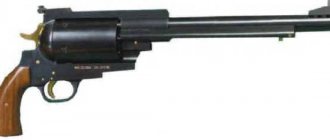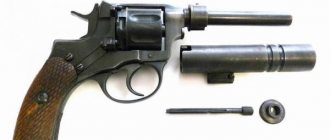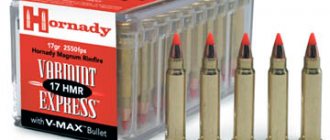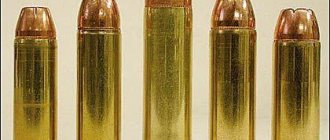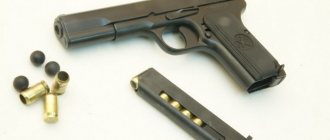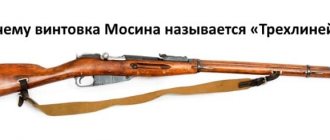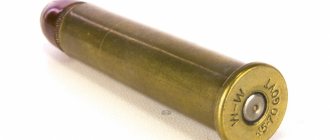For the first time, a cartridge for the Mauser K-96 pistol-carbine mod. 1896 came to the Russian Empire even before the First World War. And before that, the “ancestor” of the 7.63×25 mm Mauser cartridge (in American transcription .30 Mauser), the 7.63 mm Borchard cartridge for the C93 pistol (model 1893) by the German designer Borchard, became the “father” of not only the TeTesh cartridge, but also the most famous, most famous pistol cartridge on planet Earth, the 9x19 mm Parabellum.
“The first German 7.63 mm Mauser pistols mod. 1896 appeared in Russia even before the start of the First World War, and since 1908 they were included in the list of weapons allowed to be purchased at their own expense by officers of the tsarist army. During the fighting of 1914-1917, their number increased significantly due to German and Turkish trophies, and later they were widely used on all fronts of the Civil War.” Wikipedia.
And then there was a revolution, a Civil War, devastation, restoration of the national economy and... preparation for a new war.
The Mauser pistol cartridge was simply lucky. Firstly, the pistol was very popular among the command staff of the Red Army. Secondly, the caliber of the cartridge coincided with the caliber of rifles and machine guns already produced in the Russian Empire, 0.3 inches or 7.62 mm. Therefore, pistol barrels for this cartridge could be made from defective barrels of Mosin rifles and Maxim machine guns. This circumstance provided a huge economic gain.
Loading the integral magazine of a Mauser C96 pistol using a clip Photo: M62, ru.wikipedia.org
And one more important circumstance. It’s not for nothing that the Mauser K-96 is called a pistol-carbine. The bullet, thanks to the high power of the powder charge, is capable of killing a person at a distance of up to a thousand meters. Note that this is a pistol cartridge! That is why some experts consider this cartridge not a pistol cartridge, but a specific submachine gun.
License and equipment for the production of the .30 Mauser cartridge mod. 1896 were officially purchased from the German company DWM. Next, the top military leadership of the USSR decided to design a new pistol and promising submachine guns specifically for this cartridge. The development of weapons for this cartridge began already in 1929.
To increase manufacturability and easier extraction (ejection of spent cartridges), the width of the groove was increased. The case muzzle is slightly elongated for better bullet retention. The original Mauser capsule was replaced with a Berdan capsule, which was used in the 7.62x38 mm cartridges produced at that time for the Nagan revolver. The bullet in the Soviet cartridge is somewhat elongated. The cartridge cases were made first from expensive brass, then from cheap bimetal. The TT pistol did not yet exist in nature, and the cartridge was simply called 7.62x25 mm to distinguish it from the German-made Mauser cartridge.
Cartridges: 7.65 mm Browning, 7.62×25 mm TT, 9×19 mm Parabellum Photo: ru.wikipedia.org
Specifications:
- Caliber: 7.62 mm, or 0.3 inches.
- Bullet length: 16.3 mm or 16.5 mm (for a bullet with an all-steel core).
- Initial bullet speed: 420 m/s.
- Bullet energy 470 J.
Source: Wikipedia.
The experience of World War II showed the correctness of the choice of cartridge. Thanks to unification, the cartridge was used in both TT pistols and submachine guns (PPD, PPSh, PPS). The flat trajectory made it possible to shoot twice as far as from German machine pistols; this is a huge advantage in war. In 1943, tracer and armor-piercing modifications of this cartridge also appeared.
Tokarev pistol arr. 1933 Photo: ru.wikipedia.org
Advantages
The highest penetration of the Tokarev cartridge bullet. Especially the all-steel one. Police officers in Hong Kong, where bandits have many Chinese-made TT pistols, wear special body armor called “Tokarevsky”, class A3, when on duty. And American hunters use a carbine chambered for the TeTesh cartridge to hunt animals with thick skin - for example, wild boar. At the same time, due to the low energy, the bullet does not spoil the meat, but leaves a neat hole in it, unlike modern high-speed rifle cartridges, the bullet of which rotates in the carcass, making a chopped “steak” stuffed with bone fragments in the place of the bullet channel.
A large section of the flat trajectory, which ensures fairly accurate shooting at a distance of up to 200 m.
Encyclopedia of weapons
Cartridge 7.62x25 mm TT, 1930, Russia
Performance characteristics of 7.62x25 TT
Caliber, mm — 7.62 Cartridge length, mm — 35 Case length, mm — 25.10 Bullet weight, g — 5.52 Cartridge weight, g — 10.2 Powder charge weight, g — 0.52 Initial bullet velocity, m/s — 420 — 455 Muzzle energy, J — 508 — 576
The basis for the creation of the 7.62×25 cartridge was the 7.63 mm Mauser cartridge, which was developed by the brothers Friedrich, Fidel and Joseph Federle on the basis of the 7.65 mm Borchardt cartridge of the 1893 model, under the leadership of Paul Mauser specifically for the K pistol -96.
The Russian army bought cartridges for the Mauser pistol in service from the German company DWM. In 1929, the Artillery Committee proposed developing domestic pistols chambered for the 7.63 mm Mauser cartridge, planning to use it in the future for submachine guns.
The first batches of new cartridges were practically no different from the branded 7.63x25 Mauser cartridges, but in 1930 the cartridge underwent some modernization and was put into service under the name “7.62 mm pistol cartridge of the 1930 model.”
The first batches of new cartridges were practically no different from Mauser cartridges. In 1930, the cartridge underwent some modernization. It received a larger diameter capsule, unified with a revolver, and a wider groove on the sleeve, which made it possible to increase the strength of the ejector tooth in automatic weapons. The appearance of the bullet has changed somewhat. Increasing the radius of the ogive increased the length of the bullet head and improved its ballistic characteristics.
The bottle-shaped cartridge case is made of brass, steel or bimetallic. The bullet jacket is usually steel, clad with tombak.
The 7.62x25 cartridge has several modifications:
— 7.62 mm pistol cartridge with a bullet with a lead core (7.62 P). GAU index - 57-N-132. Basic cartridge, adopted for service in 1930. Has a brass case and a bullet with a lead core.
— 7.62 mm pistol cartridge with an armor-piercing incendiary bullet (7.62 P-41). Entered service in 1941. The P-41 bullet, weighing 4.3 - 5.1 g, had a tip painted black with a red belt. The cartridge is designed for shooting at gas tanks, motorcycles, cars and low-flying aircraft. Under the shell of the armor-piercing incendiary bullet (“P41”) there is an armor-piercing core placed in a lead jacket, and the head of the bullet is filled with a pyrotechnic incendiary mixture.
— 7.62 mm pistol cartridge with a tracer bullet (7.62 PT). Entered service in 1943. The “PT” bullet produced a bright red trail at a distance of up to 400 m and served for target designation in battle. It consists of a steel shell clad with tombak, a lead core and a sleeve with a pressed tracer compound. Its top was painted green. The cartridge has a bimetallic (GAU Index - 57-T-133) or brass (GAU Index - 57-T-132) sleeve. Cartridges with tracer and armor-piercing incendiary bullets were used exclusively in submachine guns.
— 7.62 mm pistol cartridge with a steel core bullet (7.62 PS). Adopted into service in 1953. The cartridge has a bimetallic (GAU Index - 57-N-134S) or brass (GAU Index - 57-N-132S) sleeve.
— There were blank (7X5) and training (7X6) cartridges. Instead of a bullet, the blank cartridge had a barrel compressed into a “star”. The training cartridge was used for safe training in the skills of loading and unloading weapons; accordingly, it did not have a powder charge.
— We also produced standard 7.62x25 caliber cartridges (with a steel core bullet) to compare with the characteristics of ammunition stored in warehouses for a long time and determine their suitability for further storage. The bullet of this cartridge is painted white.
| Comparative performance characteristics of the 7.62×25 mm cartridge: | ||||
| 7.62 P | 7.62 P-41 | 7.62 PT | 7.62 PS | |
| Cartridge characteristics: | ||||
| Caliber | 7.62×25 TT | 7.62×25 TT | 7.62×25 TT | 7.62×25 TT |
| Chuck length, mm | 34,81…34,85 | 34,81…34,85 | 34,81…34,85 | 34,81…34,85 |
| Cartridge weight, g | 10,2…11,1 | 9,85…10,67 | 10,20…10,95 | 9,85…10,70 |
| Characteristics of the powder charge: | ||||
| Powder type | smokeless, pyroxylin | smokeless, pyroxylin | smokeless, pyroxylin | smokeless, pyroxylin |
| Brand of gunpowder | VP, P-125 | VP, P-45 | VP,P-45 | P-45 |
| Powder charge mass, g | 0,48…0,60 | 0,48…0,56 | 0,48…0,58 | 0,48…0,52 |
| Loading density, g/cm3 | 0,659 | 0,659 | 0,682 | 0,598 |
| Maximum pressure of powder gases, MPa | 211,2 | 211,2 | 211,2 | 211,2 |
| Bullet characteristics: | ||||
| Bullet type | shell | shell | shell | shell |
| Bullet weight, g | 5,45…5,60 | 4,75…5,16 | 5,38…5,40 | 5,32…5,58 |
| Bullet length, mm | 13,8…14,0 | 16,7…16,9 | 16,4… 16,6 | 16,3…16,5 |
| Diameter of the leading part of the bullet, mm | 7,80…7,85 | 7,80…7,85 | 7,80…7,85 | 7,80…7,85 |
| Bullet ballistic coefficient, m2/kg | 9,59 | 10,41 | 9,95 | 9,63 |
| Bullet jacket material | steel clad with tombac | steel clad with tombac | steel clad with tombac | steel clad with tombac |
| Bullet shell mass, g | 1,1…1,2 | 1,2…1,3 | 1,35…1,39 | 1,3…1,4 |
| Bullet core material | lead mixed with 1...2% antimony | tool steel U10, U12, U12A | lead mixed with 1...2% antimony | steel St10 |
| Bullet core mass, g | 4,25…4,37 | 2,25…2,50 | 3,40…3,45 | 2,2…2,3 |
| Sleeve characteristics: | ||||
| Sleeve shape and type | bottle, wafer | bottle, wafer | bottle, wafer | bottle, wafer |
| Weight of cartridge case with primer, g | 4,72…4,90 | 4,72…4,90 | 4,72…4,90 | 4,29…4,31 |
| Sleeve length, mm | 24,45…24,70 | 24,45…24,70 | 24,45…24,70 | 24,45…24,70 |
| Sleeve material | brass; brass clad steel | brass | brass | steel clad with tombac |
| Bullet mounting method | tight fit and 3-point punching | tight fit and 3-point punching | tight fit and 3-point punching | tight fit and 3-point punching |
| Additional information: | The top of the bullet is painted black with a red belt | The top of the bullet is painted green | ||
| Cross-sectional area of the barrel bore (TT pistol), cm2 | 0,476 | 0,476 | 0,476 | 0,476 |
| Initial bullet speed (TT pistol), m/s | 415…445 | 455…485 | 400…430 | 415…445 |
| Muzzle energy of a bullet (TT pistol), J | 469,3…554,5 | 491,7…606,9 | 430,4…499,2 | 458,1…552,5 |
Chambered for the 7.62x25 cartridge, such small arms as the TT pistol, PPD, PPSh, and PPS submachine guns were created and adopted by the Soviet Army in the USSR.
The casings of Soviet 7.62x25 cartridges did not have marks until 1942, since all cartridges were produced by the same factory. Later, in 1944, on the bottom of the cartridge case, in addition to the factory mark and year of manufacture, they began to put the month of manufacture.
Ammunition from the period of the Second World War cannot be recommended for purchase, since the requirements for technological discipline (in terms of ensuring the reliability of ammunition during long-term storage) were simplified, and currently the quality of such cartridges is questionable.
Bulgarian-made 7.62x25 cartridges were produced in the fifties of the twentieth century at a cartridge factory in the city of Kazanlak. The code on the sleeve is “10”. The initial flight speed of the bullet is about 470 m/s. In the West, for their large muzzle flash and loud sound when fired, they received the name “Fireball express” (flight of ball lightning).
7.62x25 cartridges are made in China and are currently being mass produced and have good reliability indicators when firing. They have the following, “31”, “41”, “61”, “71”, “81”, “321”, “661”, “947”. The muzzle velocity of the bullet is about 470 m/s. The cartridge was used in China for the Type 51 pistol, Type 50, 43 submachine guns.
7.62x25 cartridges produced in Poland were produced until the mid-fifties of the twentieth century, with o or “343” placed in an oval, and the year of manufacture, which was stamped to the left of the primer. To the right of the capsule there are usually two more numbers, obviously indicating the batch number.
The speed reaches 490 - 530 meters per second. There have been cases when the speed of the bullet changed from shot to shot by thirty to forty percent. With such a spread of speeds, ammunition is dangerous when shooting, so you should be extremely careful when selecting these cartridges.
The 7.62x25 Czechoslovak cartridges provide a muzzle velocity of about 500 meters per second. These cartridges are the most preferred, but it must be remembered that in Czechoslovakia in the 1950-1960s, a reinforced 7.62x25 caliber cartridge was produced for the Model 52 pistol and the 24 and 26 submachine guns. The initial bullet speed of this ammunition reached 550-560 meters per second. Such a cartridge cannot be used for shooting from a TT pistol, since weapon breakdowns and accidents may occur.
Hungarian-made 7.62x25 cartridges are currently produced with a primer composition that does not cause weapon corrosion. However, you need to be careful when purchasing these cartridges - there have been cases when ordinary Polish or Bulgarian cartridges were offered under the guise of Hungarian ones. Since the early 1950s, the Model 48 pistol was produced in Hungary, which was an exact copy of the Soviet TT pistol, except that the coat of arms of the Hungarian People's Republic was depicted on the linings.
7.62x25 cartridges produced in Germany were produced in the fifties of the twentieth century at two enterprises with codes “04” and “05”. To the right of the capsule was a six-pointed star.
Romanian-made 7.62x25 cartridges had two codes: “21 RPR” and “22 RPR,” where the letters denoted the English abbreviation of the country’s name.
Yugoslav-made 7.62x25 cartridges are little known and practically do not enter the foreign market.
Under this cartridge in Yugoslavia, the M-54 pistol was first produced, which was an exact copy of the Soviet TT pistol of the 1933 model, and later the M-57 pistol, which differed from the previous model in an elongated handle and, accordingly, a magazine that could hold more than eight (like the M-54 ), and nine rounds.
Iraqi-made 7.62x25 cartridges are still produced today. The plant code consists of two symbols: a triangle - the Arabic numeral “five” and a letter - “press”. Below the capsule is the year of manufacture in Arabic numerals. The cartridges are more or less high quality. The Iraqi-made TT pistol has been in service with the Iraqi army since the mid-twentieth century. In 1991, the Iraqi TT pistol again “sniffed gunpowder” during the Gulf War, proving itself to be a good weapon. Hundreds of Iraqi TTs were exported to the United States as captured ones.
American-made 7.62x25 cartridges are the most preferred for purchase. Among those that produce them en masse is Kor-Bon.
Currently, the most common cartridges in the countries of the former USSR are mainly Polish, Czech and Chinese-made.
Despite the fact that both the TT cartridge and pistol have long been withdrawn from service and are almost never produced in Russia (since almost a billion TT cartridges remain in military warehouses since the Great Patriotic War), the high-velocity 7.62x25 TT cartridge has always posed a serious threat to police officers in many countries around the world.
For example, police officers of the Royal Hong Kong Police put on reinforced body armor of the third protection class A+ before going on duty, since they often encounter criminals armed with TT pistols (usually made in China). A 10 mm “auto” caliber pistol bullet penetrates only half of the vests of the second class of protection (standard US police vest), while the “tetash” bullet “sews” this vest right through.
Due to high reliability and comparative cheapness, both the pistol and the TT cartridge (most often made in Iraq, brought to the United States by American soldiers as a war trophy) have gained considerable popularity among US citizens.
It is possible that the appearance on the American arms market of pistols chambered for 7.62x25 will push ammunition manufacturers to master the production of cartridges with expansive action bullets, which will put the TT cartridge on the same level as the world's best "manstoppers" (as powerful pistol pistols are designated in the USA). and revolver cartridges (literally translated as “man-stopper”).
‹ Cartridge 7.62Х38 SP-3 Up Cartridge 7.62х39 ›
- 149144 views
Flaws
The main disadvantage is the low stopping effect (SPA). The OD of the 7.62 TT cartridge, calculated using General Hatcher’s well-known formula, is equal to 171. For comparison, the 9x19 mm Parabellum cartridge has an OD of 270, and the .45 ACP cartridge has an OD of 670 units.
Cartridge .45 ACP Photo: Malis, ru.wikipedia.org
What do these numbers say? Here's what it's about. To compare the stopping power of the American pistol cartridge .45 ACP and 7.62 TT, you need to divide 670 by 171. It turns out 3.91. That is, to obtain the same stopping effect, other things being equal, a person must be hit with either one 45-caliber bullet or four TTs. And this is in a battle where both opponents will move... And quickly! However, the designers managed to overcome this drawback. For example, police cartridges, the bullet of which consists of pellets in an elastic plastic shell, have a stopping effect of about 600 units.
An ancient Berdan primer contains a substance that destroys the barrel.

